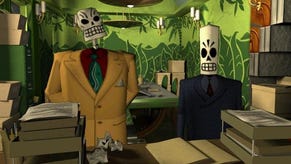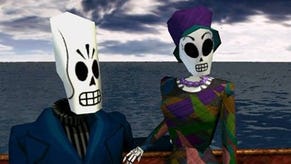Retrospective: Grim Fandango
Dead can dance.
It's only fitting that Grim Fandango takes place in the Land of the Dead, because in hindsight it represents something of a eulogy for the declining adventure genre. LucasArts' penultimate adventure game (its swansong was the anticlimactic Escape From Monkey Island) may well be its best. It helped cement director Tim Schafer as something of a superstar, prone to appear on late-night talk shows and host awards ceremonies despite Grim Fandango and his biggest games (Psychonauts, Brutal Legend) being commercial failures. Before we were all swayed by open worlds, 3D combat, and an influx of shooters, Grim Fandango proved that there's still some life left in those dusty bones.
The story of Manny Calavera - a grim reaper brilliantly reimagined as a travel agent - uncovering a web of corruption in the Land of the Dead is part Mexican folklore and part film noir. Given how well Grim Fandango blends the latter with a traditional adventure game template makes it a wonder why this hasn't been done more, since both genres are predicated on crafty problem-solving, deception and wry humour.
Recently we've had Phoenix Wright and L.A. Noire attempt to rectify this, but their protagonists were straight shooters, limiting their deductions to snooping around crime scenes and calling bluffs. Manny, however, frequently resorts to sabotage, blackmail, flirtation, manipulation and fraud to get what he wants. It's not that Manny's a bad guy - rather that he's a good guy in a bad world forced to stoop to everyone else's level to make any progress.

Where noir is typically thought of as dark, it's worth noting that many of the writers who established the genre like Dashiell Hammett and Raymond Chandler frequently injected humour to add levity and contrast with the bleak subject matter. Grim Fandango is no exception.
In the game's funniest scene Manny tricks an all-too-willing security guard, Carla, into strip-searching him, so he can sweet talk her out of her metal detector. Upon taking him in the back room, she uses this intimate setting to unload her life story onto him. She rants about her unhappy childhood at the farm, her mother's drinking problem, and her father leaving.
All the while Manny can chime in to console or mock her. Yet she rambles on, oblivious to his input, and the conversation only ends when Manny brings up the metal detector ("Maybe Daddy left because you wouldn't SHARE things..."). Here, Manny is taking advantage of a sweet innocent girl who desperately needs someone to listen. But Carla's no saint, too self-absorbed to register what Manny has to say. Both characters are selfish yet sympathetic, their interactions summing up the cutthroat yet ultimately lovable Land of the Dead.
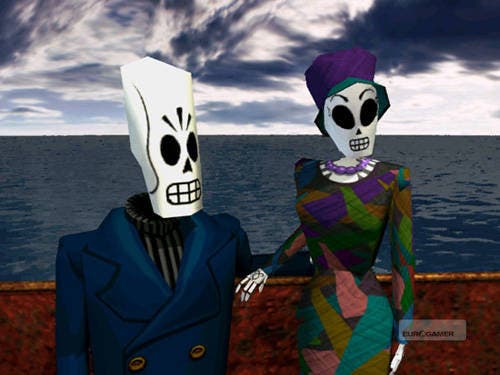
Even Manny's most basic observations are revealing. Upon examining a deck of cards in his office, he remarks, "This deck of cards is a little frayed around the edges, but then again so am I and I've got fewer suits..." It's a loaded sentence, telling us at once that Manny is unkempt and downtrodden, has a sharp wit with a penchant for puns - and, on a more practical level, that the deck of cards is tattered. This terse efficiency would be praised in the best scripts from Hollywood's Golden Era before wordplay played second fiddle to special effects. It's exposition and humour woven seamlessly together, and it's what makes Grim Fandango's script so special.
Despite the snappy dialogue, Grim Fandango isn't afraid to let its sombre undertones peek through occasionally. Many characters die (again) through a process called "sprouting", wherein a toxin causes their bones to grow flora. In one of the game's most shocking scenes, a girl is murdered for knowing too much. As her body blossoms into a bouquet she admits to Manny that she used to have a thing for him and wonders if she would have had a chance. Manny, despite being a master con artist, can't bring himself to lie to her and simply looks away. It's tragic and not the least bit fair, but them's the breaks, kid.
Elsewhere Manny interrogates a coroner whose scientific pursuits fly in the face of the festive fantasy world. He hypothesises that the Ninth Underworld - the land of eternal rest - is nothing but an old wives' tale, and what we have right now is all there is. His sobering sentiment is beautifully reflected by his wistful musing, "We may have years, we may have hours, but sooner of later, we push up flowers."
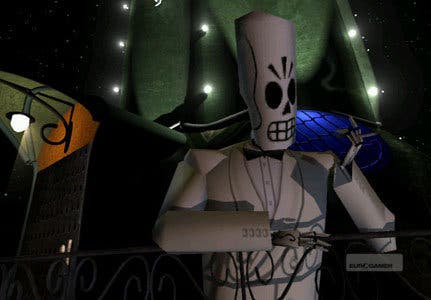
Aside from the writing, Grim Fandango is also memorable for its unique setting. Typically Mexican folklore and noir don't go hand in hand - heck, when Orson Welles made Touch of Evil, a thriller set in Mexico, he cast Charlton Heston as a Mexican. Noir is normally associated with the scummy burgs of Chicago or New York, the labyrinthine cobblestone streets of Eastern Europe, the phony glitz and glamour of Hollywood, or the haunting American Gothic undertones of the Big Easy. Mexico instead bears the burden of being where you go to set a Western or a story about drug dealers. Or both if you're Call of Juarez. Grim Fandango eschews this in favor of a colourful art deco metropolis, and it's one of the most wondrous settings ever burned to a disc.
The Land of the Dead is bursting with detail. A Mad Men-esque skyscraper has a rope made of neckties forming an escape route out of your superiors' offices, and a beatnik (or "dead beats" as Manny calls them) club is an azure palace called "The Blue Casket", where the entrance is shaped like a coffin. Look beyond the blocky, pixellated character models and low-res cut-scenes and the pre-rendered 2D backdrops hold up remarkably well nearly a decade and a half on.
My favourite chapter takes place in a bustling den of vice called Rubacava. Equal parts Las Vegas, Monte Carlo and Casablanca, it's a gorgeous monument to money and power, catering to the wealthy with nowhere to go. A cat racing track rakes in the big bucks, the snooty Blue Casket appeases the revolutionary wannabes and a giant zeppelin hovers tantalisingly out of reach, while Manny runs a crooked casino converted from an old automat.

It's in Rubacava that the structure of the game opens up exponentially, and where Manny has to complete three large, multi-step missions to gain passage on an ocean liner. A callback to the opening chapter of Monkey Island, this act contains the game's best puzzles. Deducing when a photo was taken based on close observation and peripheral knowledge scattered throughout the world remains an inventive brainteaser that relies on greater intuition than simply combining items.
Besides the savvy dialogue and moody environments, Grim Fandango emulates film in one other important respect: it has no HUD. Interactive objects are emphasised by Manny's head turning towards them, and your inventory is rifled through via the keyboard with close-ups of each item as Manny digs through his breast pocket. It was a noble endeavour, even if it still had kinks to work out. Movement is stiff, and often it's unclear what you can interact with if objects are close together (particularly cumbersome where doors and their locks register as separate interaction points). If the game gets a re-release, I hope there will be an option to highlight interactive hotspots in a fashion similar to Monkey Island 2's Special Edition.
Grim Fandango remains a shining testament to a bygone era. Just as classic films relied on clever banter and moody lighting before action took center stage, Grim Fandango's chief pleasures are mostly timeless. Its mile-a-minute punch-lines, stellar voice-acting, dazzling scenery, and well-rounded characters remain as enchanting now as they were 13 years ago. While the game delves into the sordid lives of the dead, the biggest crime of all is that it isn't available on Steam or GOG. Just because Grim Fandango is about the dead, that doesn't mean it should stay buried.
Playing the game again in 2015? We've got a handy walkthrough if you're stuck somewhere.
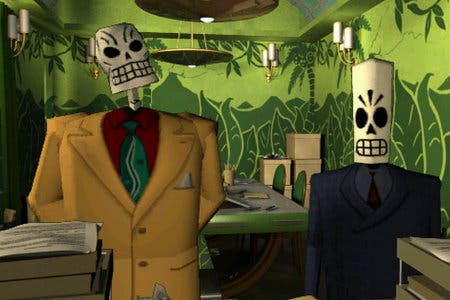

.jpg?width=291&height=164&fit=crop&quality=80&format=jpg&auto=webp)
